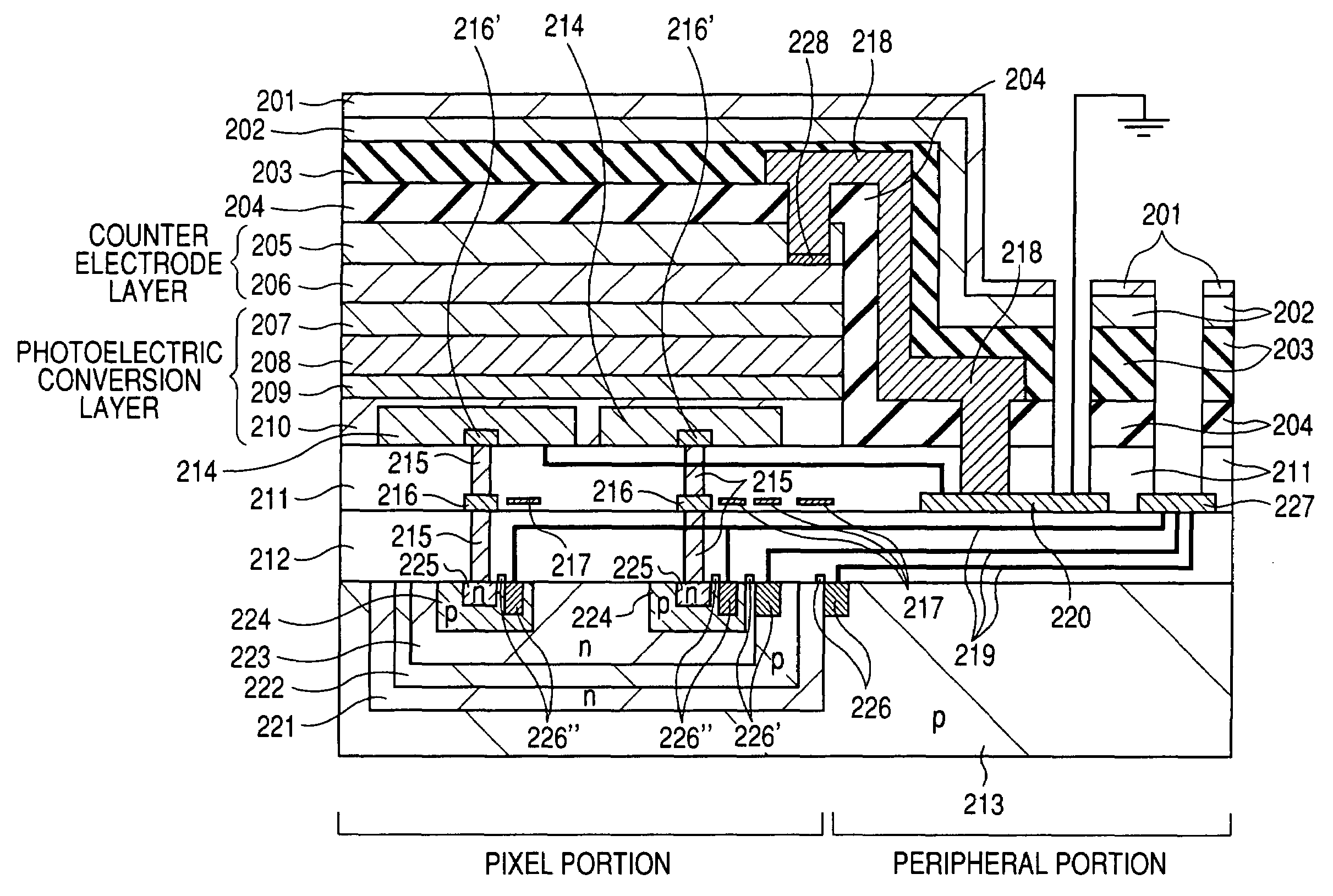Functional layer having wiring connected to electrode and barrier metal between electrode and wiring
a technology of functional layer and wiring, which is applied in the direction of ceramic layered products, discharge tube luminescent screens, transportation and packaging, etc., can solve the problem of increasing the light quantity loss due to optical reflection, inability to allocate sufficient large area to light-receiving portions, and existing imaging devices with several tens of percentages of light quantity loss, etc. problems, to achieve the effect of improving performance, good operation durability characteristics, and satisfactory performan
- Summary
- Abstract
- Description
- Claims
- Application Information
AI Technical Summary
Benefits of technology
Problems solved by technology
Method used
Image
Examples
first embodiment
[0089]The photoelectric conversion layer-stacked solid-state imaging devices can have various structures, including a first structure which permits color imaging by depositing above a silicon substrate three photoelectric conversion layers, each of which is made up of two electrode layers and an organic material sandwiched between them, and detecting lights of three different colors above the silicon substrate and a second structure which is like as the structure shown in FIG. 5 of JP-A-2003-332551 and permits color imaging by depositing above a silicon substrate one photoelectric conversion layer made up of two electrode layers and an organic material sandwiched between them, forming two pn junctions inside the silicon substrate at positions differing in depth and detecting lights of two different colors inside the silicon substrate and light of another color above the silicon substrate. Taking the second structure as an example, a first embodiment of the invention is illustrated.
[...
second embodiment
[0130]In a second embodiment of the invention, the functional device has a structure that the second electrode layer is divided among pixels and a conductor trace is connected to each piece of the divided second electrode layer via barrier metal. Taking a luminescent device as an example, the second mode of functional device is illustrated below. The luminescent device is a device used in a display or the like. The following illustration is made taking the area emitting light for representing one pixel of an image as one pixel.
[0131]FIG. 13(a) is a schematic surface view showing a configuration outline of two pixels among those constituting the luminescent device, FIG. 13(b) is a schematic cross-sectional view taken on line α-α′ of FIG. 13(a), FIG. 13(c) is a diagrammatic drawing showing an example of a driving circuit of the luminescent device, and FIG. 13(d) is a diagrammatic drawing showing a traditional example of the driving circuit of a luminescent device. In FIG. 13(a), the c...
third embodiment
[0146]A third embodiment of the invention is illustrated with taking as an example of the structure of a photoelectric conversion layer-stacked solid-state imaging device the first structure that permits color imaging by depositing above a silicon substrate three photoelectric conversion layers, each of which is made up of two electrode layers and an organic material sandwiched between them, and detecting lights of three different colors above the silicon substrate.
[0147]FIG. 26 is a schematic surface view of a photoelectric conversion layer-stacked solid-state imaging device for illustrating the third embodiment of the invention. The photoelectric conversion layer-stacked solid-state imaging device 1100 shown in FIG. 26 has a great many light-receiving portions (pixels) 1101 arrayed in a grid pattern, or a matrix of pixels, in this example.
[0148]On the surface of a semiconductor substrate provided underneath the light-receiving portions 1101 in the photoelectric conversion layer-st...
PUM
| Property | Measurement | Unit |
|---|---|---|
| edge length | aaaaa | aaaaa |
| thickness | aaaaa | aaaaa |
| thickness | aaaaa | aaaaa |
Abstract
Description
Claims
Application Information
 Login to View More
Login to View More - R&D
- Intellectual Property
- Life Sciences
- Materials
- Tech Scout
- Unparalleled Data Quality
- Higher Quality Content
- 60% Fewer Hallucinations
Browse by: Latest US Patents, China's latest patents, Technical Efficacy Thesaurus, Application Domain, Technology Topic, Popular Technical Reports.
© 2025 PatSnap. All rights reserved.Legal|Privacy policy|Modern Slavery Act Transparency Statement|Sitemap|About US| Contact US: help@patsnap.com



